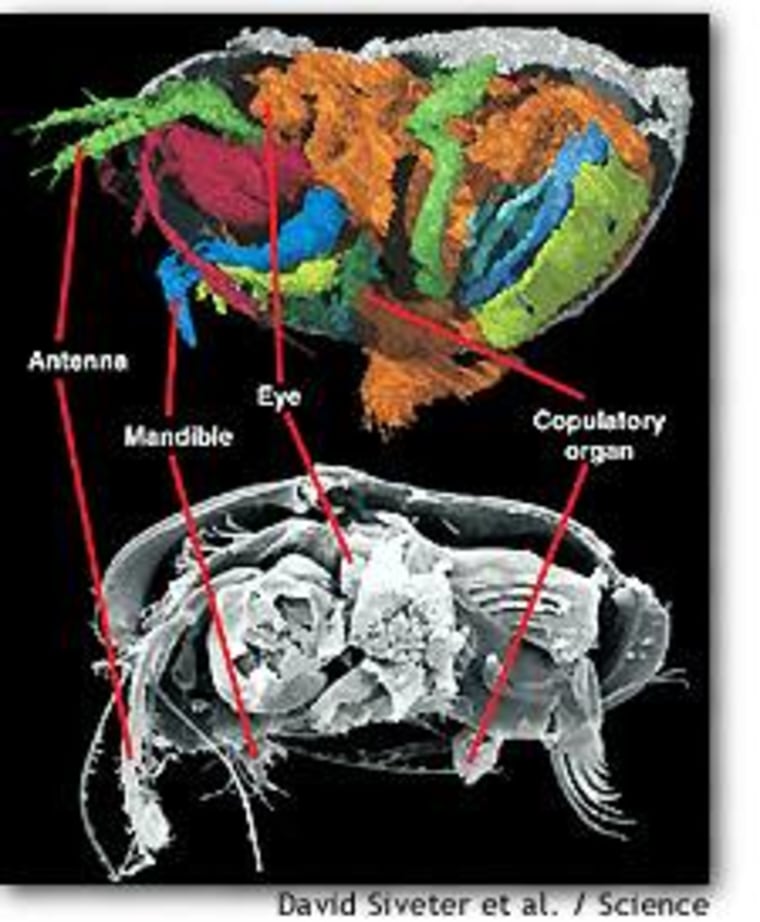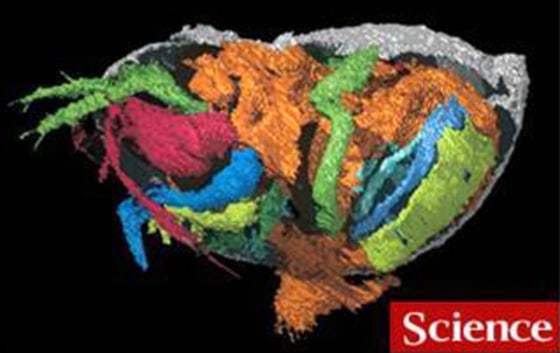Scientists have discovered what may be the oldest known unequivocally male animal fossil. Like the male leads in the film “The Full Monty,” this 5-millimeter crustacean from Britain bares all — though he has a lot more to offer than his copulatory organ.
The exquisitely preserved soft parts of the 425-million-year-old relative of the crab, lobster and barnacle are rare and telling. The find also pushes the earliest date for a soft-tissue fossil from this prolific group of crustaceans called “ostracodes” back by almost 200 million years — helping to fill a wide gap in the fossil record.
To glean information from the tiny creature, the researchers created a virtual fossil whose digital contours provide new insights on crustacean evolution. The fossil bears striking similarities to some shelled, aquatic animals living today. These findings are described in the Dec. 5 issue of the journal Science, published by AAAS, the non-profit science society.
“I could only dream about finding something like this. It’s like Christmas every day,” said Science author David Siveter, a professor of paleontology at the University of Leicester in Britain.
The researchers have discovered a wide range of animal fossils alongside this ostracode. The variety suggests that they may have stumbled upon a preserved seafloor animal community from the time in Earth’s history when animals and plants appear to have made the leap from water to land.
‘Swimmer with a large penis’
Ostracodes, or “seed shrimp,” are small crustaceans with a hinged pair of shells. The shells protect the soft body, a region that includes the stomach, shell-moving muscles, eyes, reproductive organs and a respiratory and circulatory system. With many thousands of living and extinct marine and fresh water species, ostracodes are the most abundant arthropods in the fossil record. They are also common today — even in garden ponds.
Ostracodes pass through a series of juvenile stages and discard several outgrown shells on their way to adulthood. The researchers behind the Science study discovered a sexually mature male ostracode from about 425 million years ago.

“It has the world’s oldest penis. If there is another one, I don’t know it,” Siveter said.
While this may be the first example of the male sex in the fossil record, the male gender is thought to be present before this time.
The ostracode’s limbs suggest that he was a swimmer and scavenger that cruised above the ocean floor. As the discoverers of the new species, David Siveter and his co-researchers from Oxford University and Yale University provided the name Colymbosathon ecplecticos, which means “swimmer with a large penis.”
Releasing this fossil from the rock required ingenuity and digital technology. The fossil and surrounding rock were composed essentially of the same material, calcium carbonate, the primary component of limestone rock. The scientists abandoned common fossil-extraction techniques and focused on color and photography to separate animal from mineral.
An acid application would have eaten away both the rock and the fossil. Manually picking away at the rock could have damaged the fossil and would never have yielded the high-resolution details captured in the virtual fossil, according to Siveter.
To produce their computer-generated images of the fossil, the researchers played on the color differences between the blue-black outlines of the fossil and the tan colors in the surrounding rock. First, they ground away layers of the fossil — 20 micrometers at a time — taking pictures after removing each layer. They repeated this grind-and-photograph process until their prized fossil was nothing but dust.
When the dust settled, however, the scientists held a massive amount of detailed visual information on how the soft parts of this sea creature were put together.
With the right software, David Siveter and colleagues merged their pile of sequential digital pictures into video files and still images of the fossil. While the scientists can’t hold their three-dimensional fossil, they can click through its insides and examine the biological writing on its virtual walls.
A seafloor time capsule
The scientists found the fossil rock in ancient volcanic ash from a site in England’s Herefordshire County, on the Wales border.
After an eruption, falling ash probably filtered down to the ocean floor, smothering an entire animal community, including the new ostracode species — but not crushing it. A form of calcium carbonate known as calcite filled the insides of the animals on the ocean floor. Round rocks called nodules eventually formed around the fossils and protected them from the squashing nature of geologic time.
From the same site where the scientists discovered the ostracode, they have also recovered soft-bodied worms, sponges, snails, many other types of arthropods including a relative of the king crab, a creature resembling a mollusk, and echinoderms — a group whose modern members include starfish and sea urchins.
Siveter explained that finding uncrushed fossils of soft-bodied worms — highly fragile animals — suggests that the entire ecosystem could be intact at this site.
“The scientific prospects are great. We may be able to reconstruct a complete seafloor animal community,” he said.
The newly discovered ostracode fossil is remarkably similar to some modern ostracodes. These similarities suggest an extremely low rate of evolutionary change over the last 425 million years.
If one of these contemporary crustaceans had a chance to talk to the old male fossil, he might cite the lyrics of Neil Young: “Old man, look at my life, I’m a lot like you were.”
